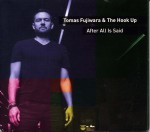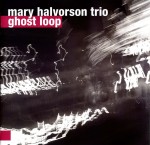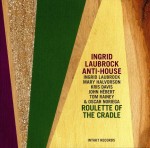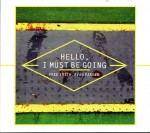As the Guelph Jazz Festival (GJF) settles into maturity, dependable musical choices and the vagaries of touring mean that a few of the performers at this year’s bash, September 16 to 20, are featured in more than one ensemble. The happy end result is that the audience gets to sample some musicians’ skills in more than one challenging setting.
 Take drummer Tomas Fujiwara for instance. On September 17 at Heritage Hall (HH), he’s one-third of the Thumbscrew band with guitarist Mary Halvorson and bassist Michael Formanek, Then on September 20 at the Guelph Little Theatre (GLT) he and Halvorson are part of cornetist Taylor Ho Bynum’s sextet. After All is Said, Fujiwara’s CD with The Hook Up (482 Music 482-1089) includes Halvorson and Formanek, plus tenor saxophonist/flutist Brian Settles and trumpeter Jonathan Finlayson. Displaying rare ability as a composer as well as a percussionist – all seven tunes are his – Fujiwara’s lines are rife with unselfconscious conviviality. At the same time, as a piece like Boaster’s Roast demonstrates, effervescent riffs don’t mask the tune’s rugged core, which his thrashing patterns and the guitarist’s intense vibrations supply. Similarly on Solar Wind, smooth horn harmonies back the drummer shaping Native Indian-like tom-tom beats to a jazz program. With themes usually passed from instrument to instrument throughout, there’s also space for Settles’ (Stan) Getzian flutter tones, hocketing leads from Finlayson and unique interludes from Halvorson that move chameleon-like from folksy strumming to obdurate power chords.
Take drummer Tomas Fujiwara for instance. On September 17 at Heritage Hall (HH), he’s one-third of the Thumbscrew band with guitarist Mary Halvorson and bassist Michael Formanek, Then on September 20 at the Guelph Little Theatre (GLT) he and Halvorson are part of cornetist Taylor Ho Bynum’s sextet. After All is Said, Fujiwara’s CD with The Hook Up (482 Music 482-1089) includes Halvorson and Formanek, plus tenor saxophonist/flutist Brian Settles and trumpeter Jonathan Finlayson. Displaying rare ability as a composer as well as a percussionist – all seven tunes are his – Fujiwara’s lines are rife with unselfconscious conviviality. At the same time, as a piece like Boaster’s Roast demonstrates, effervescent riffs don’t mask the tune’s rugged core, which his thrashing patterns and the guitarist’s intense vibrations supply. Similarly on Solar Wind, smooth horn harmonies back the drummer shaping Native Indian-like tom-tom beats to a jazz program. With themes usually passed from instrument to instrument throughout, there’s also space for Settles’ (Stan) Getzian flutter tones, hocketing leads from Finlayson and unique interludes from Halvorson that move chameleon-like from folksy strumming to obdurate power chords.
 Additional instances of Halvorson’s skills are evident on Ghost Loop (ForTune 0010/010 for-tune.pl), except here, unlike Thumbscrew, she is joined by solid bassist John Hébert and drummer Ches Smith. Smith’s ingenious approach to percussion can be heard at the GJF though. On September 18 he’s part of saxophonist Darius Jones’ quartet at the GLT and at the A place the next night he works double duty in both Marc Ribot’s Ceramic Dog trio and the Bly De Blyant band. A live date from Poland, Ghost Loop (No.43) effectively demonstrates how much can be done with just three instruments, as themes encompassing the most pliable pastoral patterns or the most raucous battering ram-like authority, and much in-between, are elaborated. On Existential Tearings (No.44) for instance the three could be mistaken for a heavy metal trio as Halvorson’s harsh twangs mirror Smith’s anvil-hard pump. Meantime following an expansive scene-setting intro from Hébert, the guitarist fashions a multi-hued tone exposition on the title tune as if she had 88 piano keys at her disposal. Expressing the band’s overall duality, the final Deformed Weight of Hands (No.28) is both blunt and balanced, with the guitarist relaxing into legato picking to temper Smith’s furious, but always controlled, rumbles.
Additional instances of Halvorson’s skills are evident on Ghost Loop (ForTune 0010/010 for-tune.pl), except here, unlike Thumbscrew, she is joined by solid bassist John Hébert and drummer Ches Smith. Smith’s ingenious approach to percussion can be heard at the GJF though. On September 18 he’s part of saxophonist Darius Jones’ quartet at the GLT and at the A place the next night he works double duty in both Marc Ribot’s Ceramic Dog trio and the Bly De Blyant band. A live date from Poland, Ghost Loop (No.43) effectively demonstrates how much can be done with just three instruments, as themes encompassing the most pliable pastoral patterns or the most raucous battering ram-like authority, and much in-between, are elaborated. On Existential Tearings (No.44) for instance the three could be mistaken for a heavy metal trio as Halvorson’s harsh twangs mirror Smith’s anvil-hard pump. Meantime following an expansive scene-setting intro from Hébert, the guitarist fashions a multi-hued tone exposition on the title tune as if she had 88 piano keys at her disposal. Expressing the band’s overall duality, the final Deformed Weight of Hands (No.28) is both blunt and balanced, with the guitarist relaxing into legato picking to temper Smith’s furious, but always controlled, rumbles.
 Halvorson and Hébert are among the players who make up saxophonist Ingrid Laubrock’s Anti-House sextet on Roulette of the Cradle (Intakt CD 252 intaktrec.ch); the others are pianist Kris Davis, clarinetist Oscar Noriega and drummer Tom Rainey. The careful dynamics that unite the players can be experienced in a fashion at the GJF when Davis’ Capricorn Climber band featuring Laubrock and Rainey plus bassist Trevor Dunn and violist Mat Maneri is at GLT September 17. Meandering like a country road, Laubrock’s most vigorous CD interface with Davis occurs on …and Light (for Izumi), which blends pointillist reed tinctures with hearty Chopinesque intimations from the pianist. Composed like the other tunes by the saxophonist, Silence… (for Monika) with Rainey’s reverberating bell pealing and unhurried strums and sweeps from Hébert could be confused with 1950s cool jazz – that is until Halvorson’s sour clanks yank it into 2015. Davis’ solid comping that extends lines with the swiftness and regularity of a teletype machine is angled leftwards to meet Laubrock’s emotional reed slurs on the title tune; while Face the Piper, Part 2 demonstrates how the guitarist’s jagged-edge approach transforms a composition from regularized swing. Still the CD’s defining track is From Farm Girl to Fabulous, Vol.II, where homespun inflections, suggested by Davis’ upright-piano-like woody plunks and mandolin-like strokes from the guitarist, accompany a reed transformation as Laubrock’s output begins simply and concludes with smirking urbane and gritty urban enunciation.
Halvorson and Hébert are among the players who make up saxophonist Ingrid Laubrock’s Anti-House sextet on Roulette of the Cradle (Intakt CD 252 intaktrec.ch); the others are pianist Kris Davis, clarinetist Oscar Noriega and drummer Tom Rainey. The careful dynamics that unite the players can be experienced in a fashion at the GJF when Davis’ Capricorn Climber band featuring Laubrock and Rainey plus bassist Trevor Dunn and violist Mat Maneri is at GLT September 17. Meandering like a country road, Laubrock’s most vigorous CD interface with Davis occurs on …and Light (for Izumi), which blends pointillist reed tinctures with hearty Chopinesque intimations from the pianist. Composed like the other tunes by the saxophonist, Silence… (for Monika) with Rainey’s reverberating bell pealing and unhurried strums and sweeps from Hébert could be confused with 1950s cool jazz – that is until Halvorson’s sour clanks yank it into 2015. Davis’ solid comping that extends lines with the swiftness and regularity of a teletype machine is angled leftwards to meet Laubrock’s emotional reed slurs on the title tune; while Face the Piper, Part 2 demonstrates how the guitarist’s jagged-edge approach transforms a composition from regularized swing. Still the CD’s defining track is From Farm Girl to Fabulous, Vol.II, where homespun inflections, suggested by Davis’ upright-piano-like woody plunks and mandolin-like strokes from the guitarist, accompany a reed transformation as Laubrock’s output begins simply and concludes with smirking urbane and gritty urban enunciation.
 Sharing the double bill with Capricorn Climber is the sole GJF appearance of vibraphonist Jason Adasiewicz’s Sun Rooms trio. However From The Region (Delmark DE 5017 delmark.com)’s 11 tracks itemize why the full-barrelled improvisations of Adasiewicz, drummer Mike Reed and bassist Ingebright Håker-Flaten mean the three are continually busy with their own groups as well as with North American and European stylists, some of whom are featured at the GJF. Considering Håker-Flaten’s string slapping is as percussive as the others’ output, Sun Rooms could be the practice studio of three drummers. With an instrumental bounce as forceful as any vibist since Lionel Hampton, Adasiewicz as composer/player adds the delicate sensibility of Milt Jackson and Gary Burton when needed. In fact, a trio of appealing tunes – The Song I Wrote for Tonight, Mae Flowers and Mr. PB – shows off this lyrical bent. Each succinctly melds rhythmic colours and emotional melodies, augmenting the results into a sway as gentle as a summer breeze. Stentorian swagger and strength characterize many of the other tracks though. The bassist’s rugged timing steadies the tunes, the drummer adds irregular and broken patterns to their exposition and Adasiewicz consistently seeks novel, raw but unifying tones to judder sympathetically alongside the others’ contributions.
Sharing the double bill with Capricorn Climber is the sole GJF appearance of vibraphonist Jason Adasiewicz’s Sun Rooms trio. However From The Region (Delmark DE 5017 delmark.com)’s 11 tracks itemize why the full-barrelled improvisations of Adasiewicz, drummer Mike Reed and bassist Ingebright Håker-Flaten mean the three are continually busy with their own groups as well as with North American and European stylists, some of whom are featured at the GJF. Considering Håker-Flaten’s string slapping is as percussive as the others’ output, Sun Rooms could be the practice studio of three drummers. With an instrumental bounce as forceful as any vibist since Lionel Hampton, Adasiewicz as composer/player adds the delicate sensibility of Milt Jackson and Gary Burton when needed. In fact, a trio of appealing tunes – The Song I Wrote for Tonight, Mae Flowers and Mr. PB – shows off this lyrical bent. Each succinctly melds rhythmic colours and emotional melodies, augmenting the results into a sway as gentle as a summer breeze. Stentorian swagger and strength characterize many of the other tracks though. The bassist’s rugged timing steadies the tunes, the drummer adds irregular and broken patterns to their exposition and Adasiewicz consistently seeks novel, raw but unifying tones to judder sympathetically alongside the others’ contributions.
 While the majority of these GJF improvisers who often work together are young, a constantly innovative stylist like British saxophonist Evan Parker, 71, continues to operate as he has for the past half century: partnering with as many musicians as possible. His September 17 HH performance is with baritone saxophonist Colin Stetson, while he hosts trumpeter Peter Evans and electronics exponents Ikue Mori and Sam Pluta September 19 at the GLT. Suggesting how he will play during both concerts is Hello, I Must Be Going (Victo cd 128 victo.qc.ca). Another Canadian live concert, from last year’s Festival International de Musique Actuelle de Victoriaville, it’s a duo session, this time with guitarist Fred Frith, 66. Frith’s command of the electric guitar is such, though, that he adroitly presages some of the electronic patterns Mori and Pluta come up with, as well as being fully conversant with his instrument’s rhythmic and melodic tasks. Notably, when both players are in full improvisational flight, searching for novel timbres, it’s only Frith’s powerful strums that confirm that a guitar is being used. Otherwise he comes across like an actor inhabiting multiple roles in a one-man play. For instance, processed drones and clicks meet the saxophonist’s flutter-tongued slurs on the title track, while Frith’s resonating contributions to Particulars come from what sounds like a mutant grafting of strings onto a combination of tabla and conga drum. On the concluding Je Me Souviens, unbridled sonic elation is attained, as Parker’s chortling pitch variations turn straight ahead as Frith responds with abbreviated spurts of rhythm through concentrated string pumping. Red Thread is the paramount instance of the duo’s work, however. As Parker’s crimped reed quacks accelerate to a protracted allotment of circular breathing, Frith mirrors the reed lines with electronically processed modular flanges as well as supplying a connective bass line. The climax has the saxophonist exchanging eviscerating tone for luminous tone vibrations as the guitarist complements Parker’s new narrative with rugged yet reassuring rubber band-like twangs.
While the majority of these GJF improvisers who often work together are young, a constantly innovative stylist like British saxophonist Evan Parker, 71, continues to operate as he has for the past half century: partnering with as many musicians as possible. His September 17 HH performance is with baritone saxophonist Colin Stetson, while he hosts trumpeter Peter Evans and electronics exponents Ikue Mori and Sam Pluta September 19 at the GLT. Suggesting how he will play during both concerts is Hello, I Must Be Going (Victo cd 128 victo.qc.ca). Another Canadian live concert, from last year’s Festival International de Musique Actuelle de Victoriaville, it’s a duo session, this time with guitarist Fred Frith, 66. Frith’s command of the electric guitar is such, though, that he adroitly presages some of the electronic patterns Mori and Pluta come up with, as well as being fully conversant with his instrument’s rhythmic and melodic tasks. Notably, when both players are in full improvisational flight, searching for novel timbres, it’s only Frith’s powerful strums that confirm that a guitar is being used. Otherwise he comes across like an actor inhabiting multiple roles in a one-man play. For instance, processed drones and clicks meet the saxophonist’s flutter-tongued slurs on the title track, while Frith’s resonating contributions to Particulars come from what sounds like a mutant grafting of strings onto a combination of tabla and conga drum. On the concluding Je Me Souviens, unbridled sonic elation is attained, as Parker’s chortling pitch variations turn straight ahead as Frith responds with abbreviated spurts of rhythm through concentrated string pumping. Red Thread is the paramount instance of the duo’s work, however. As Parker’s crimped reed quacks accelerate to a protracted allotment of circular breathing, Frith mirrors the reed lines with electronically processed modular flanges as well as supplying a connective bass line. The climax has the saxophonist exchanging eviscerating tone for luminous tone vibrations as the guitarist complements Parker’s new narrative with rugged yet reassuring rubber band-like twangs.
The musical interconnections on these CDs set such a high standard that memorable GJF performances can be expected every day of the festival.



